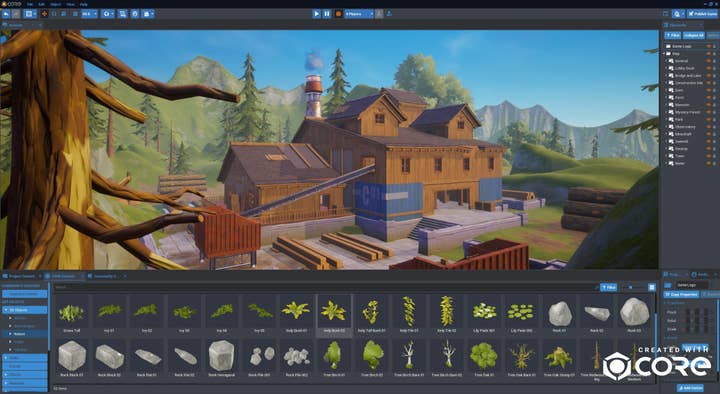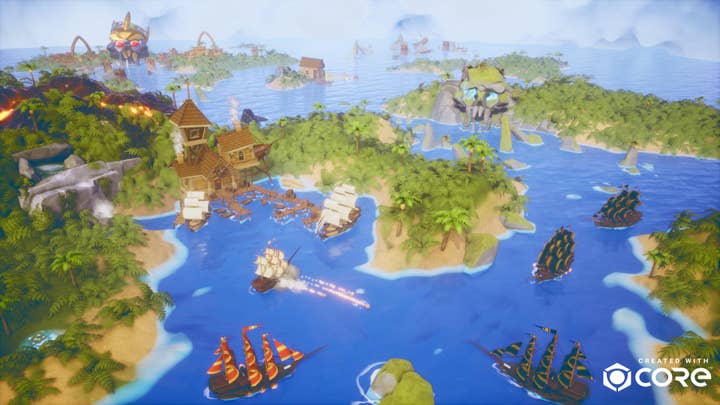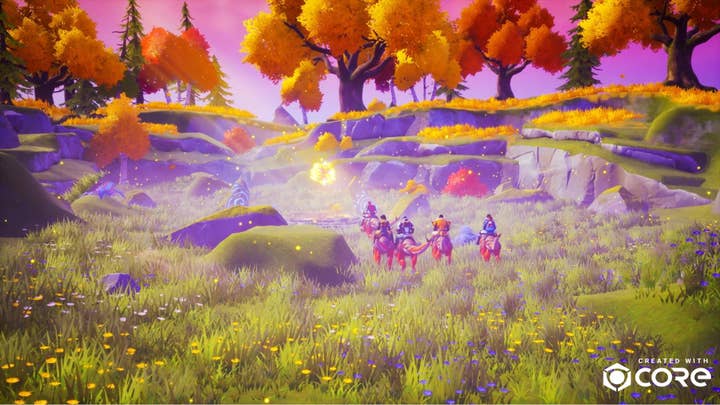Manticore Games is building a "truly level playing field" for game development
CEO Frédéric Descamps hopes to disrupt game creation in the way that YouTube and Twitch did broadcasting
If one trend has defined the recent history of the games business, it's the emergence of the battle royale. PlayerUnknown's Battlegrounds and Fortnite achieved startling levels of success and popularity that are all the more remarkable considering where the genre came from: a series of mods created by one person with a limited grasp of the technical side of game development.
Battle royale was not a feat of engineering, but a triumph of design. It was the right execution of a truly great idea, using tools widely available to the gaming community. With PUBG, Brendan Greene changed the face of gaming, and he did so without a deep understanding of how to code.
That story is at the heart of what Manticore Games hopes to achieve with Core, a new platform for the creation, publishing and playing of games. The company's marketing points toward a future in which Core will allow pretty much anyone to make a real-time multiplayer experience, build a community, and even earn a living from doing so -- the kind of pitch that it's tempting to file squarely under "too good to be true."
"We already have co-op games, single-player games, we have parkour games, adventure games, social hangout games"
Frédéric Descamps
"We hear that a lot," says Frédéric Descamps, Manticore Games' co-founder and CEO. "When we're demoing to very big companies that have a lot of experience in gaming and have made game engines before, they're like 'no, no, no -- that's not possible'."
One only needs to look at Manticore's two funding rounds -- $15 million in 2017, and another $30 million last year -- to see that doubters tend to change their minds when they see what the San Francisco-based firm has been building for the last three years.
"Making games is very, very hard, to the point that 90% of all games are commercial failures, 90% of game studios are running out of money and closing their businesses," Descamps continues. "It's a sad state of affairs, if you ask me.
"One of the reasons there is so little commercial success is because of barriers. There are lots of barriers to making games: choosing an engine; you need a team of very specialised people; you have to make strategic decisions about your game design... Later on publishing, later on finding funding, and then maybe you get a chance to make your game."

In part, Core is a response to this landscape of challenges and pitfalls -- as Descamps describes it: "A one-stop shop for creating, developing, collaborating, publishing, findinding your audience -- all of it." In an hour-long demo, Core's mettle as a platform for the creation of real-time multiplayer games is very much to the fore. This is consistent with all of the company's messaging and marketing, and there is a simple reason for that being Manticore's focus.
"This is the hardest form of games today," Descamps says. "You need absolute precision. If I'm playing Apex Legends or Fortnite and it goes under 60 milliseconds, I start crying... This is the top, but you can do anything with the engine. We already have co-op games, single-player games, we have parkour games, adventure games, social hangout games.
"It doesn't have to be multiplayer -- that's just the hardest thing to do. Let's have that out of the box, and people can use it or not."
"We've worked on games where there were no fewer than 12 tools involved... Even when it's your own company, you're not allowed to make changes"
Frédéric Descamps
Core is built on top of Unreal Engine and uses Lua for scripting. Users can dig deep if they wish, but at its most basic the creation process is a matter of accessing menus, dragging and dropping. The user can build on one of the frameworks provided by Manticore -- battle royale, deathmatch, king of the hill, and so on -- or start from a completely clean slate, adding assets, logic and systems from Core's generously stocked library.
"This is what we've provided as Manticore to be really high quality art, assets, particles, textures -- things like that," says COO Jordan Maynard, who put together a competent third-person arena shooter with a mountainous desert backdrop from these pre-fabricated parts in 15 minutes.
However, while the "Core Content" that Manticore provides will guarantee a certain quality standard, it is really just the starting point for what will ultimately be available to users; all of those assets can be tweaked, changed, remixed and repurposed by the community, which can then choose to share those new creations with others.
Maynard's desert scene was covered with palm trees, for example, an item actually created by a user from a duplicated fern model and a textured cylinder. To provide a more extreme example, we saw a gigantic model of the Golden Gate Bridge in one game, which was entirely constructed from a single chair leg, painted red and reproduced over and over again. Manticore calls this process "asset smashing", and it can produce something as simple as a gun or as elaborate as a "construction kit" template for an entire genre.

"At first we were worried that it would be too restrictive for the creators," Maynard says, referring to the fact that users won't be able to import assets created with external tools. "But people are actually more creative when they have those Lego sets to build with.
"Will Wright used to talk about this with The Sims -- the UGC [user-generated content] pyramid. You have 1% who are technical and can write something [complicated], but as long as you have one person in your community who can do that, the next ten people are probably technical enough to take that and make something out of it, and the next 100 people can make something else out of it."
The best example we saw of this tendency was a portal gun, which functioned exactly the same as the iconic weapon from Valve's celebrated series. Th portal gun was created by a user who knew enough Lua to write it into existence, and now everyone can use a portal mechanic in their games. Maynard describes this as "opt-in complexity" -- the idea that Core's users can create anything from a tree to a complicated mechanic to an entire game genre using the same tool, and then immediately share it and change the way everyone else thinks about their own creations.
"We want to reward, very handsomely, the best creators who make the best games"
Frédéric Descamps
"Development pipelines are typically very complex, very codified, very regimented," Descamps says. "We've worked on games where there were no fewer than 12 tools involved, and then you have to integrate that into an engine... Even when it's your own games and your own company, you're not allowed to make changes. It can take weeks."
In Core, that process is streamlined and atomised, allowing iteration on specific ideas to take place across its entire audience. While real-time multiplayer is a specialty, Manticore showed a wide variety of games made in the engine: a Warcraft-esque third-person RPG, a first-person sc-fi horror, a top-down pirate combat game, and something called "Gettin' Squirelly" that defied simple classification.
The fact that all of these game types are constructed from assets within the Core platform means that the client for each is only a few hundred kilobytes. This allows for rapid transitions between games, a user experience that Manticore takes every single opportunity to compare to YouTube. This can be through the Core storefront -- which will display new games, featured games, new work from popular creators, etc. -- or from within the games themselves. Users will be able to create links between their own games, or those of people in their community of friends, using portal gates, which will allow social groups to roam Core's ecosystem of experiences together.
Every user, whether player or creator, will have an avatar, designed using the vast array of customisation options in Core's character editor. These avatars will represent the user in both the creation tool and the games it produces, giving them a consistent presence within the ecosystem. It also represents one of Manticore's most important revenue streams at this early stage.

"We do want to create an economy for the creators," Descamps says. "This is a very important part of what we do. We want to reward, very handsomely, the best creators who make the best games."
All Core games will be free to create and free to play, Descamps says, and the main sources of revenue for Manticore will be the sale of cosmetics for player avatars, and "special programmes" similar to season passes and battle passes. For the creators, the company is exploring "direct ways for creators to receive money from the players," but it has nothing concrete to share at this point in time.
"The youngest, most junior people on our team are building complex games and complex worlds"
Frédéric Descamps
"The plan for now is not to give the creators tools to monetise their own games," Descamps says. "I think that ends up in a very ugly place, very quickly, but we want the best creators to make money, and maybe even make a living... One of my goals is to have a 15 year-old in England, and she could be one of the top publishers on Core, and she's making so much money she doesn't go to college."
However, while Manticore is quick to compare its platform to the likes of Unity and Unreal Engine in terms of accessibility, it is a very different prospect in terms of making money. While those engines can export to virtually any platform and storefront, a game built with Core stays in Core. According to Maynard, this all-or-nothing proposition speaks to the scale of the company's ambition.
"Our goal is to make it so you wouldn't want to [sell a game on Steam]," he says. "The path of least resistance to getting your game made, getting it published, and getting it seen by millions of players, should be through Core."
Assessing an idea as large as this one is difficult, so far-reaching are the company's goals. What is clear is that, for Manticore's plans to work, Core will need to be very popular -- the free-to-play business model will need millions of users to function properly, and its creators will need a large enough addressable market for their work to yield financial returns.
Indeed, while Descamps draws a parallel between Core and the major game engines, the intended audience here is those who would find even something like Unity too demanding. While many companies have trumpeted a goal of "democratising" game development -- Descamps states a preference for "game creation" as a descriptor for what happens with Core -- none have done so to the degree that YouTube and Twitch have made broadcasting accessible to anyone with a webcam and an idea. If Manticore hits its targets, it will spark "a new wave of creativity" from a new kind of creator.
"The youngest, most junior people on our team are building complex games and complex worlds," says Descamps. "The user interface still looks technical, but if you compare it to any of the leading engines, it's much, much easier to use... There is nothing like it out there, in terms of ease of use and speed.
"You still need many, many years of experience for Unity. You can give this to your interns, you can give it to your QA folks... It's a truly level playing field. It's going to be super interesting to see what people make, but also see who they are."


